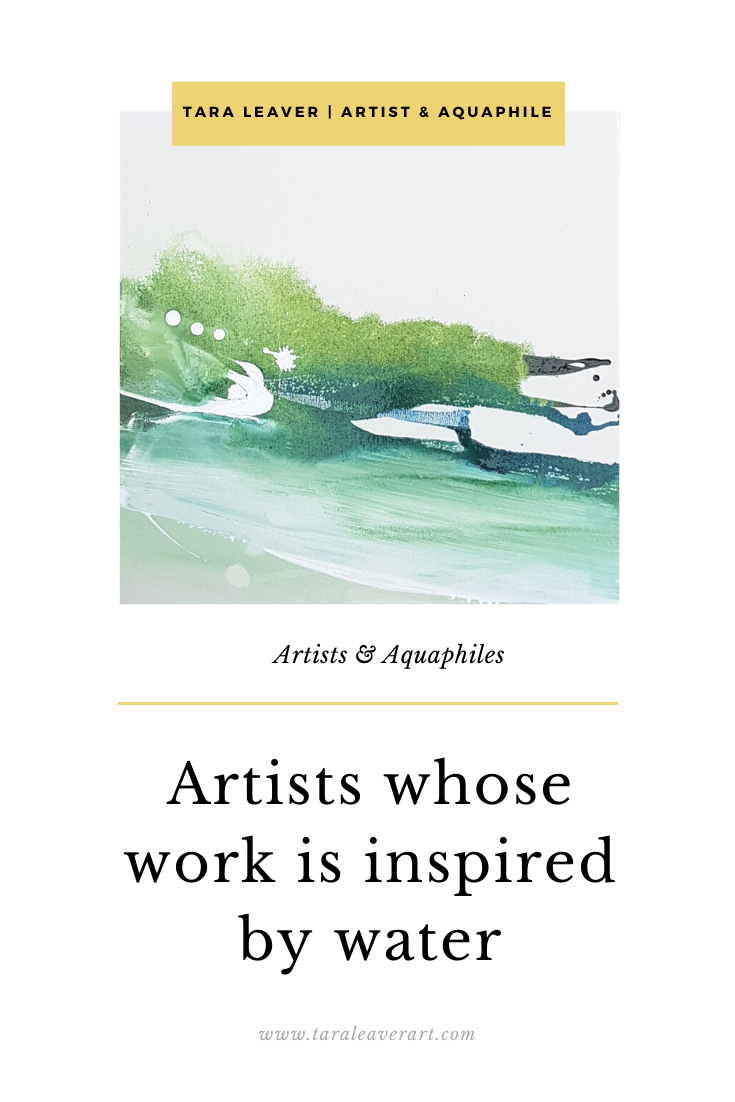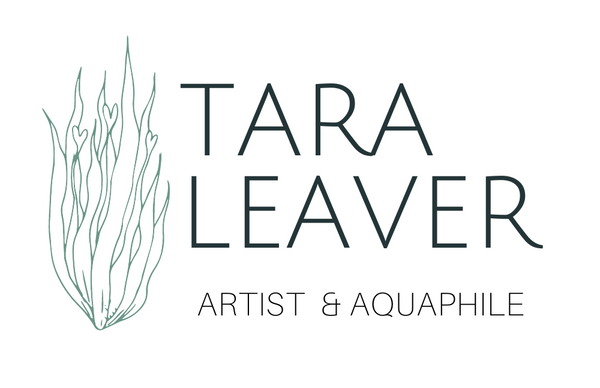
Aquaphiles: artists and water
Share
Typically I shrug off labels, preferring to be more fluid {ha} and unpindownable, but when I discovered this word, it felt so true I decided to adopt it:
Aquaphile: someone who loves water or the ocean - someone who loves to swim
Quite honestly I think most, if not all of us have an aquaphile inside us, to varying degrees. We are each, after all, around 60% water, living on a planet that is 70% covered by it. It’s just that for some of us the call of the waves is stronger.
My work hasn’t always been about water, specifically. It wasn’t really until I moved to live by the sea and cleared the vision-obscuring fog of long term depression out of my system that I fully realised how significant it is to me, and as a Pisces it isn’t really that surprising I suppose.
I noticed recently that some of my favourite art and artists deal with water; some were already inspirations, others I only discovered more recently, well into my aquatic explorations. Today I’m sharing four of them; unintentionally all British.
Emily Ball
"My children were learning to swim and I sat by the pool watching them being held up by the water. I cannot swim and this detachment increased my fascination of how they moved, floated and finally began to swim so beautifully through the water."
I’ve been in love with Emily Ball’s swimming paintings for years. Hers is for me the kind of work you wish you’d made, knowing you’d never be able to because that wasn’t your art to make, but you dream of it all the same.
She made a series called Floating World, inspired by watching her children learn to swim, and followed it with further explorations called Swim the Body Electric.
To me she somehow captures viscerally and truthfully the experience of being in water - something I’m constantly aiming for in my own work. Her mark making is out of this world.
Clockwise from top left: Learning to Swim, Evie Swimming, Float Shimmer Dive

Tania Kovats
"I want my work to speak to our liquid selves, the part of our identities that is fluid and shifting and hard to hold."
A much more recent discovery for me, Tania Kovats’ work is more conceptual. It fascinates me in a completely different way, partly because it is so different, and yet deals with the same overall subject.
Her focus is more on the environment; she’s travelled extensively to research and create her work, as well as enlisting others, as for All the Seas, an arrangement of glass bottles containing water from every sea on the planet, for which she asked people around the world to send her samples.
Her Evaporation sculpture is so beautifully thought out and constructed, and reminds me of the importance of process and materials in expressing your meaning as much as in the final outcome.
There’s a fascinating and articulate interview with her here.
Clockwise from top left: Sea Marks, All the Seas, Evaporation

Kari Furre
"The underwater world has always fascinated me. And fish skin itself is the perfect upcycling material."
Kari Furre is a sculptor and long distance, wild swimmer who lives in Devon in the UK. There’s a fantastic short video about her on her website which I recommend; I’ve watched it several times.
Her sculptures are made from fish leather, which she tans herself using sustainable Nordic techniques. She produces these delicate, translucent vessels, taking something that would otherwise be wasted, and lovingly and painstakingly crafting it into something lastingly beautiful.
I love the idea of using an actual product of the sea to make art about the sea. I love too, that this kind of 3D way of working, so different from painting in many ways, inspires me to think in a more multidimensional way about my own work.
Clockwise from top left: Oil tanned and dyed salmon, Ghost Fishing, salmon tissue bowls

Bryan Wynter
"A stream finds its way over rocks. The force of the stream and the quality of the rocks determine the stream's bed... There are no streams or rocks in my paintings but a comparable process of dynamic versus static elements has attended their development and brought about their final form."
Bryan Wynter was one of the St Ives group of artists. He moved down to Cornwall in 1945 to live in a remote and basic cottage in West Penwith, and during part of his career made paintings about water. He was very keen on canoeing, and used one to traverse many of Cornwall’s numerous waterways.
Wynter’s nature based paintings were done in such a way that the process followed the way nature behaves. For me he captures water in very evocative ways, from the obviously expressive Spate III to the more deliberate, graphic feel of Saja and Green Confluence.
It fascinates me how other artists feel into water, and come back out with these unique languages.
Left to Right: Spate III, Saja, Green Confluence

Aquaphile: someone who loves water or the ocean - someone who loves to swim
Quite honestly I think most, if not all of us have an aquaphile inside us, to varying degrees. We are each, after all, around 60% water, living on a planet that is 70% covered by it. It’s just that for some of us the call of the waves is stronger.
My work hasn’t always been about water, specifically. It wasn’t really until I moved to live by the sea and cleared the vision-obscuring fog of long term depression out of my system that I fully realised how significant it is to me, and as a Pisces it isn’t really that surprising I suppose.
I noticed recently that some of my favourite art and artists deal with water; some were already inspirations, others I only discovered more recently, well into my aquatic explorations. Today I’m sharing four of them; unintentionally all British.
Emily Ball
"My children were learning to swim and I sat by the pool watching them being held up by the water. I cannot swim and this detachment increased my fascination of how they moved, floated and finally began to swim so beautifully through the water."
I’ve been in love with Emily Ball’s swimming paintings for years. Hers is for me the kind of work you wish you’d made, knowing you’d never be able to because that wasn’t your art to make, but you dream of it all the same.
She made a series called Floating World, inspired by watching her children learn to swim, and followed it with further explorations called Swim the Body Electric.
To me she somehow captures viscerally and truthfully the experience of being in water - something I’m constantly aiming for in my own work. Her mark making is out of this world.
Clockwise from top left: Learning to Swim, Evie Swimming, Float Shimmer Dive

Tania Kovats
"I want my work to speak to our liquid selves, the part of our identities that is fluid and shifting and hard to hold."
A much more recent discovery for me, Tania Kovats’ work is more conceptual. It fascinates me in a completely different way, partly because it is so different, and yet deals with the same overall subject.
Her focus is more on the environment; she’s travelled extensively to research and create her work, as well as enlisting others, as for All the Seas, an arrangement of glass bottles containing water from every sea on the planet, for which she asked people around the world to send her samples.
Her Evaporation sculpture is so beautifully thought out and constructed, and reminds me of the importance of process and materials in expressing your meaning as much as in the final outcome.
There’s a fascinating and articulate interview with her here.
Clockwise from top left: Sea Marks, All the Seas, Evaporation

Kari Furre
"The underwater world has always fascinated me. And fish skin itself is the perfect upcycling material."
Kari Furre is a sculptor and long distance, wild swimmer who lives in Devon in the UK. There’s a fantastic short video about her on her website which I recommend; I’ve watched it several times.
Her sculptures are made from fish leather, which she tans herself using sustainable Nordic techniques. She produces these delicate, translucent vessels, taking something that would otherwise be wasted, and lovingly and painstakingly crafting it into something lastingly beautiful.
I love the idea of using an actual product of the sea to make art about the sea. I love too, that this kind of 3D way of working, so different from painting in many ways, inspires me to think in a more multidimensional way about my own work.
Clockwise from top left: Oil tanned and dyed salmon, Ghost Fishing, salmon tissue bowls

Bryan Wynter
"A stream finds its way over rocks. The force of the stream and the quality of the rocks determine the stream's bed... There are no streams or rocks in my paintings but a comparable process of dynamic versus static elements has attended their development and brought about their final form."
Bryan Wynter was one of the St Ives group of artists. He moved down to Cornwall in 1945 to live in a remote and basic cottage in West Penwith, and during part of his career made paintings about water. He was very keen on canoeing, and used one to traverse many of Cornwall’s numerous waterways.
Wynter’s nature based paintings were done in such a way that the process followed the way nature behaves. For me he captures water in very evocative ways, from the obviously expressive Spate III to the more deliberate, graphic feel of Saja and Green Confluence.
It fascinates me how other artists feel into water, and come back out with these unique languages.
Left to Right: Spate III, Saja, Green Confluence

